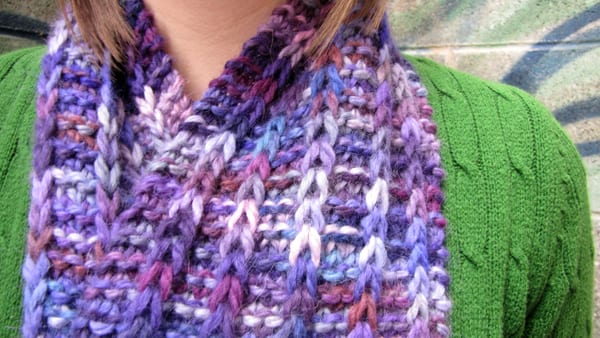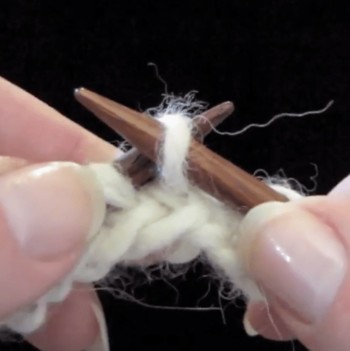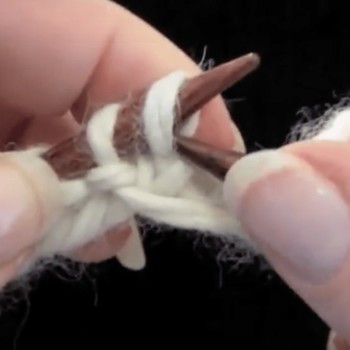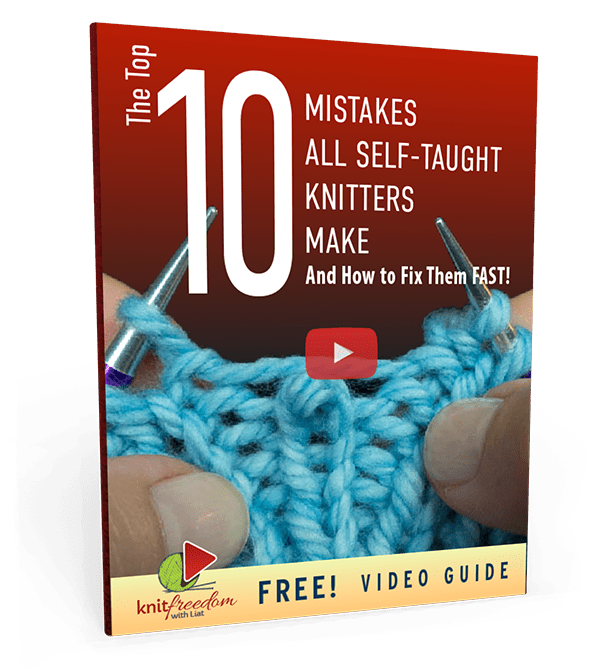Ch. 19 Project - Aubergine Dreams Scarf
It's time to keep building on the skills you've learned so far. I'm going to be teaching you a few other moves that make knit-and-purl stitch combinations even more flexible.
This chapter is going to make you an expert at reading your work, which will set you up nicely for our final chapter and challenge project.
Project – Aubergine Dreams Scarf
 This pattern stitch makes a lovely scarf, and it’s going to teach us a few new stitch-techniques at the same time.
This pattern stitch makes a lovely scarf, and it’s going to teach us a few new stitch-techniques at the same time.
Please navigate to and print out the pattern here – notice that the designer has constructed this as a short neckwarmer but I recommend that you work it as a regular scarf, without the buttons and buttonholes, which means you’ll need about three times as much yarn.
Tip: You don’t need to make this whole scarf to practice these techniques – you could just knit up a swatch until you get the hang of this stitch pattern.
You could also do the neckwarmer length and just follow the pattern’s instructions to learn how to make buttonholes. Or you could do the whole shebang. It’s up to you.
At least knit long enough to make some mistakes, so that we can learn how to fix them together.
Choosing Your Yarn
The pattern was designed with Araucanía Magallanes, an aran-weight yarn, but the project shown here was made with Misti Alpaca Hand Paint Chunky – you can see that there is a lot of flexibility with which yarn thickness you can use.
Just keep in mind that if you use a worsted-weight yarn, the scarf will be narrower, and if you use a bulky-weight yarn, the scarf will be wider. Some inexpensive, craft-store options could be Martha Stewart Crafts Alpaca Blend, or Lion Brand Wool-Ease.
A Note About Color
On this project we can veer away a little from the doctrine that knit-and-purl patterned projects need to be made with a solid-colored yarn.
As you can see from the photo, a hand-painted yarn can work really well with this project – none of the color-changes distract from the overall structure of the stitches. Misti Alpaca works well for this type of project precisely because the yarn changes colors almost every stitch, giving an overall look that is multicolored but even.
I would still stay away from variegated yarns (yarns that have random blocks of color). They look beautiful on the skein, but knitted up, the color-blocks can distract from your pattern.
Okay, you’ve got your yarn, it’s wound into balls, and you’ve got the appropriate-sized needles. Let’s get started.
Slipping Stitches

Read through the Aubergine Dreams pattern and notice the following abbreviations or instructions you may not have seen before.
- “Sl 1” means “slip 1,” and here she means as if to purl, or “purlwise”
- “Sl 1 as if to knit” means “slip 1 knitwise”
- Purl through the front loop*
Let’s look at what “slip 1” means before we get started on the scarf (*we’ll talk about “purling through the front loop” when we get to that point in the pattern).
Restricted Video
 This video is available to members of Knitting Superstar University or the following classes:
This video is available to members of Knitting Superstar University or the following classes:
If you own this class, please LOG IN to watch.
Slipping stitches is a very common way to make a chain of decorative elongated stitches in your knitting, and it is used frequently in pattern design.
Because the stitch is slipped instead of knitted, it has to stretch over two rows before it gets knitted again – this elongates the stitch and makes it stand out from the stitches next to it.
Many patterns call for “slipping the first stitch of every row,” and this is exactly what it sounds like.
It helps create a nice, even edge along the sides of scarves and other projects. In fact, our pattern here calls for exactly that, as does Jared Flood’s version of the striped Noro scarf.
If you go and look at his version of the pattern, you’ll see that he calls for an odd number of stitches to be cast on, just to accommodate an extra slipped stitch at the beginning of each row.
Slipping the first stitch of each row also helps us set up for seamed projects, because it’s very easy to sew up two pieces of knitting that have even, elongated stitches along the sides.
We’ll experiment more with that in the last chapter. Just keep this in mind when you are working on future projects: if the pattern says “slip 1” but doesn’t specify which way, slip the stitch “purlwise.”
Cast On and Work Through Scarf Pattern

Now let’s cast on together and work through this scarf pattern.
Restricted Video
 This video is available to members of Knitting Superstar University or the following classes:
This video is available to members of Knitting Superstar University or the following classes:
If you own this class, please LOG IN to watch.
Keep working through this pattern, and review the following video for what to do if you mess up.
Fix Advanced Knit and Purl Mistakes

Restricted Video
 This video is available to members of Knitting Superstar University or the following classes:
This video is available to members of Knitting Superstar University or the following classes:
If you own this class, please LOG IN to watch.
Nice work! You can finish up this scarf or pause in the middle and go on to our last scarf, and work on them both at the same time if you wish.
Make sure to link your project to Aubergine Dreams on Ravelry.

